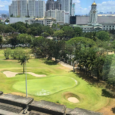Article by Desa Desiree Tayting (@dsdsrtytng)
My afternoon visit at Nonesuch Fine Collectibles and Rarities was as fine as the objects I saw – and that day, I saw them in a different light. It was a very interesting visit as it’s not everyday that you come across pieces that are not only rare in kind and quality, but also of heritage, story and culture.
It happened on October 27-29, 2017 at Peninsula Manila with several exhibitors, like Gallery Deus, Gallery Joshua, Gallery of Prints, Leon Gallery, Maria Angelica Rare Finds, Maria Closa, Natalya Lagdameo, Nicole Whisenhunt, Osmundo, Tawalisi Antiques, and Unang Panahon. I went on the 2nd day of the event and also attended a talk at Nonesuch Salon, a speakers’ series of talks that enhances the visitor experience of the fair.
(READ: 8 Must-Visit Art Galleries To Inspire Your Creativity)
It was a showcase of the vetted selection of art, antiques, furniture, jewelry, books, maps and prints, rare objects and other collectibles in a unique setting. The stage was designed by Gino Gonzales, one of Manila’s most creative set designers, who recently bagged the silver prize at the 2017 World Stage Design by the International Organization of Scenographers, Theatre Architects and Technicians held in Taipei, Taiwan. Walking along an aisle full of quality rare objects, I learned different stories and even met some curators and designers.
I first stopped by a booth full of sparkling jewels, mostly of earrings and rings. I didn’t know where to begin, so I asked the lady in charge what her favorite was and she immediately pointed at this.
It’s an antique ivory ring, which costs an arm and a leg to me; but I later understood how special it is. This was only made for a sole size of 4 and it was said that it couldn’t be made any bigger because the ivory would get damaged in the making. The lady told me the ring was finding it a little hard to find an owner. Surprisingly, I came back after a few minutes and the ring was already gone! Real quick!
I continued walking and came to a table full of antique dinnerware (mostly from Europe). It truly amazes me how they still look like they’re new. but have apparently been on Earth before me – and even before my parents! The person in charge for Mentxaka asked me, “What is the most interesting piece here?” Before I could answer, my eyes went to this beautiful dragon boat sauce. It was intricately designed that I was afraid to touch it at first. I learned that it was designed by an Italian during the 18th century.
Just across this table was where I stayed a long time. Gallery of Prints welcomed me with overwhelming and interesting facts about their rare prints.
I literally took a deep breath when I saw this. This is the first European map that appeared in Abraham Ortelius’s atlas, the creator of the first modern atlas. What interested me the most was the left part with Mindanao and Cubo (our Cebu), and the fact that we still have a copy of this here in the Philippines. This print is considered to be “extremely rare”.
I was introduced to the curator in a little while, Mr. Rudolf J. H. Lietz, and he gladly showed me more valuables. What I saw next was a collection of trade cards in Cuba depicting scenes in Philippine streets during the Spanish times. These photographs were sold with boxes of Corona cigars and each was pasted in a numbered space with a short subject caption in the image. He told me these 12 images are yet to be seen by the public. I felt so lucky at that moment.
Before I left, he also showed me this frame. This is ‘Comintang e la Conquista’ by Sir John Bowring. Some millennials may not know it, but Kumintang is a style of Philippine music from the 19th century. It’s a musical notation from ‘A Visit to the Philippine Islands in 1858-5’ published by Smith, Elder & Co. In London’. This item is considered ‘RARE’ as read in its description.
I continued walking and had a quick conversation with Maria Angelica of Maria Angelica Rare Finds who showed me these necklaces. Inside are gold pieces excavated during the 18th – 19th century. So pretty, right?
When I asked them about the interesting pieces of their shop, they brought out these coins that were used during the time when people exchanged goods or services for them. Imagine if you lived during this time! You’d have to cut off a part of this coin to trade it for a carabao. Sounds cool!
I moved to the next booth and saw this beautiful brooch. I met its curator, Nicole Whisenhunt of Whisenhunt. This one’s a restored piece and still looks very lovely to me.
My eyes caught these pieces next, which read “Bordados de Manila”. It says that in the 19th century, Filipinas wore their piety around their necks over their trajes de mestiza. The tamburin and escapulario also served as a talisman against evil. The escapulario reborn showcases the best in Filipino craftsmanship. Each piece is embroidered entirely by hand in a raised gilt silver thread. It crossed my mind to buy one if ever I get very rich someday.
And lastly, to cap off what seems to be a story-overloaded afternoon, I attended a talk about Bale (Ifugao house) by Floy Quintos.
I have this great interest in indigenous culture, especially of the people in the Cordilleras, so I was all ears for this. In his talk, photos of the original rice terraces were shown during the 90s: how Ifugao still kept the traditions and practices in the modern times, and primarily, what a real Bale looks like. He also cleared out that the Bulols are not gods, but guardians. To the Ifugaos, the Bulols are guardians of their crops, rice.
He also mentioned the ladles and spoons that were used even before the Spaniards came and influenced most of Filipinos in using them. The audience had the chance to hold and touch them.
So, what was this like as a whole for a 20-something like me? Humans tend to be different in interests and people around my age may or may not have the same appreciation as I have for these things. But I realized something when I was looking around and heard a woman in her late 40s maybe, who I guessed was also an art/antique enthusiast saying, “You know these pieces are sometimes not meant to be kept forever; it’s to be passed on”, which makes a lot of sense to me.
In my perception, the present generations are capable of making these items maintained and appreciated through time. For such stories to live on and be remembered, one must understand them first and also share them with the coming generations. I realized that it isn’t just a Tita-thing as a millennial like me tagged it first; it can be for everyone. The world is full of rich and amazing cultures, only if we have time to appreciate them.















